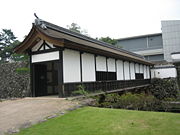
Funai Domain
Encyclopedia

Han (Japan)
The or domain was the name of the estate belonging to a warrior in Japan after the 17th century. The fiefs of the daimyos of the samurai class of Japan during the Edo period were called han.-Edo period:...
of the Edo period
Edo period
The , or , is a division of Japanese history which was ruled by the shoguns of the Tokugawa family, running from 1603 to 1868. The political entity of this period was the Tokugawa shogunate....
, located in Bungo Province
Bungo Province
was a province of Japan in eastern Kyūshū in the area of Ōita Prefecture. It was sometimes called , with Buzen Province. Bungo bordered Buzen, Hyūga, Higo, Chikugo, and Chikuzen Provinces.-History:...
(present-day Ōita Prefecture
Oita Prefecture
is a prefecture of Japan on Kyūshū Island. The prefectural capital is the city of Ōita.- History :Around the 6th century Kyushu consisted of four regions: Tsukushi-no-kuni 筑紫国, Hi-no-kuni 肥国, and Toyo no kuni...
in southern Japan).
History
Funai had been the castle of the Ōtomo clanOtomo clan
The Ōtomo clan was a Japanese clan whose power stretched from the Kamakura period through the Sengoku period, spanning over 400 years. The clan's hereditary lands lay in Kyūshū....
; however, Toyotomi confiscated it during the lordship of Ōtomo Yoshimune. In 1600, Takenaka Shigetoshi, the cousin of Takenaka Shigeharu
Takenaka Shigeharu
, who was also known as Hanbei , was a Japanese samurai during the Sengoku period of the 16th century. He initially served the Saitō clan of Mino province, but later plotted an uprising and took over the Saitō clan's castle at Mount Inaba. Toyotomi Hideyoshi was so impressed by this tactic that he...
(Hanbei), received Funai Castle, and land rated at 20,000 koku
Koku
The is a Japanese unit of volume, equal to ten cubic shaku. In this definition, 3.5937 koku equal one cubic metre, i.e. 1 koku is approximately 278.3 litres. The koku was originally defined as a quantity of rice, historically defined as enough rice to feed one person for one year...
; he had switched sides during the Sekigahara Campaign to support Tokugawa Ieyasu
Tokugawa Ieyasu
was the founder and first shogun of the Tokugawa shogunate of Japan , which ruled from the Battle of Sekigahara in 1600 until the Meiji Restoration in 1868. Ieyasu seized power in 1600, received appointment as shogun in 1603, abdicated from office in 1605, but...
. The domain was then given to Hineno Yoshiakira in 1634; however, as he died heirless, the domain was given to the Matsudaira (Ogyū) clan. The Matsudaira clan remained as lords of Funai until the Meiji Restoration
Meiji Restoration
The , also known as the Meiji Ishin, Revolution, Reform or Renewal, was a chain of events that restored imperial rule to Japan in 1868...
.
List of lords
- Takenaka clanTakenaka clanThe is a Japanese family descended from the Seiwa Genji line's Toki branch..The family, with holdings in the Fuwa district of Mino Province, was founded by Iwate Shigeuji, who was the first to take the name Takenaka.....
, 1603-1634 (TozamaTozamaA ' was a daimyo who was considered an outsider by the rulers of Japan. The term came into use in the Kamakura period and continued until the end of the Edo period.-Edo period:...
; 20,000 kokuKokuThe is a Japanese unit of volume, equal to ten cubic shaku. In this definition, 3.5937 koku equal one cubic metre, i.e. 1 koku is approximately 278.3 litres. The koku was originally defined as a quantity of rice, historically defined as enough rice to feed one person for one year...
)
- Shigetoshi (cousin of Takenaka HanbeiTakenaka Shigeharu, who was also known as Hanbei , was a Japanese samurai during the Sengoku period of the 16th century. He initially served the Saitō clan of Mino province, but later plotted an uprising and took over the Saitō clan's castle at Mount Inaba. Toyotomi Hideyoshi was so impressed by this tactic that he...
) - Shigeyoshi
- Hineno clan, 1634-1656 (TozamaTozamaA ' was a daimyo who was considered an outsider by the rulers of Japan. The term came into use in the Kamakura period and continued until the end of the Edo period.-Edo period:...
; 20,000 kokuKokuThe is a Japanese unit of volume, equal to ten cubic shaku. In this definition, 3.5937 koku equal one cubic metre, i.e. 1 koku is approximately 278.3 litres. The koku was originally defined as a quantity of rice, historically defined as enough rice to feed one person for one year...
)
- Yoshiakira
- Matsudaira (Ogyū) clanMatsudaira clanThe was a Japanese samurai clan that claimed descent from the Minamoto clan. It first originated in and took its name from Matsudaira village, in Mikawa Province . Over the course of its history, the clan produced many branches, most of which also centered around Mikawa Province...
, 1656-1871 (FudaiFudaiwas a class of daimyo who were hereditary vassals of the Tokugawa in Edo period Japan. It was primarily the fudai who filled the ranks of the Tokugawa administration.-Origins:...
; 21,000 kokuKokuThe is a Japanese unit of volume, equal to ten cubic shaku. In this definition, 3.5937 koku equal one cubic metre, i.e. 1 koku is approximately 278.3 litres. The koku was originally defined as a quantity of rice, historically defined as enough rice to feed one person for one year...
)
- Tadaaki
- Chikanobu
- Chikayoshi
- Chikasada
- Chikanori
- Chikatomo
- Chikayoshi
- Chikakuni
- Chikanobu
- ChikayoshiMatsudaira Chikayoshi; was a Japanese samurai of the late Edo period who served as daimyō of the Funai Domain . Served in a variety of positions in the Tokugawa Shogunate, including that of wakadoshiyori. Resigning from the family headship in 1871, he went into retirement.-External links:*...

